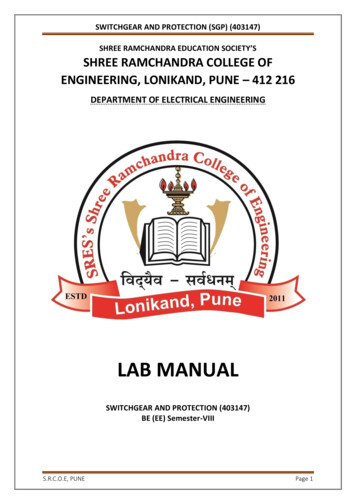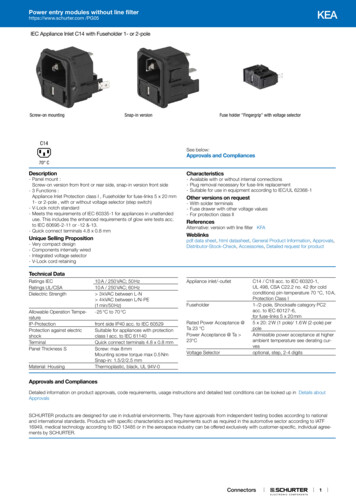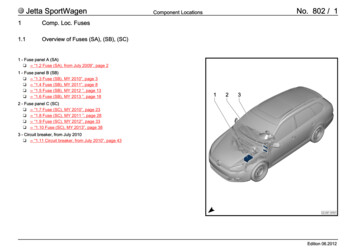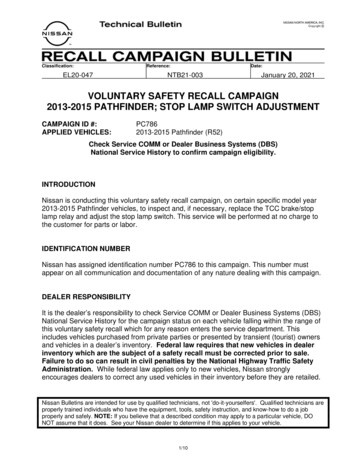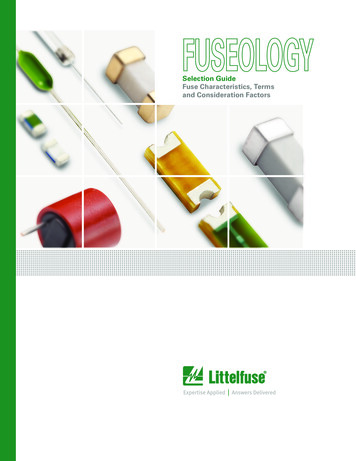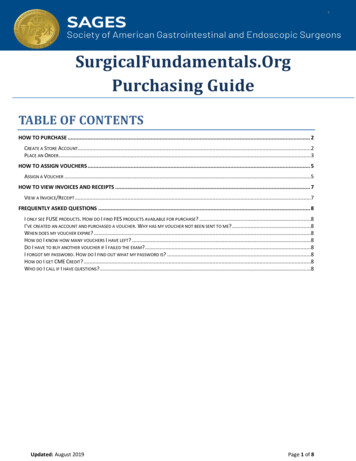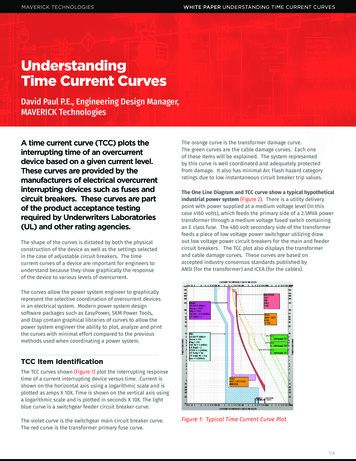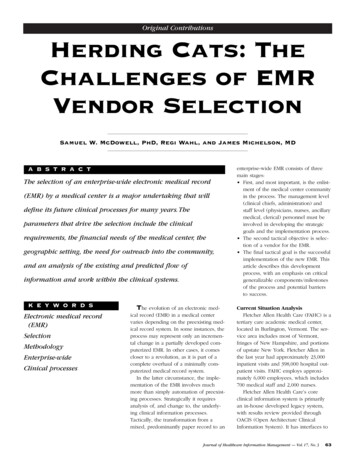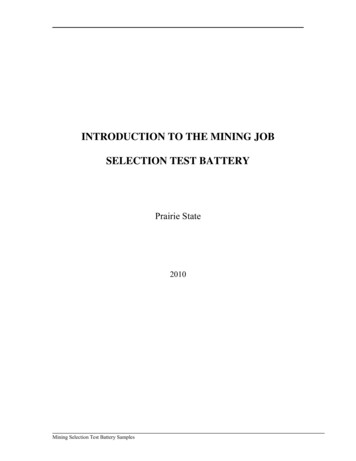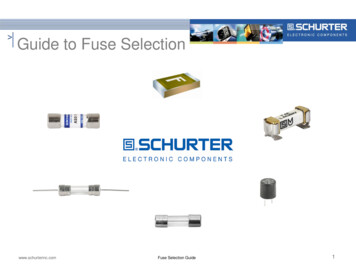
Transcription
Guide to Fuse Selectionwww.schurterinc.comFuse Selection Guide1
Purpose of Fuses Circuit protection is critical, and in many cases required, inelectrical and electronic products. Fuses are an inexpensive and effective way to protect your devicefrom damage due to overcurrent conditions. Fuses can prevent safety hazards to the end user such as fire andcatastrophic failure of the product. Fuses help design engineers comply with regulatory agenciessuch as UL and IEC.www.schurterinc.comFuse Selection Guide2
Characteristics of FusesSchurter offers a wide variety of fuses to meet any application: Package type (SMD, thru hole, cartridge)Current and voltage ratings (AC and DC power)Trip characteristics (quick-acting or time-lag)Breaking capacity ratingsApprovals (UL, CSA, ENEC, CCC)www.schurterinc.comFuse Selection Guide3
Size and Mounting Schurter offers 0402, 0603, 1206 SMD fusesThru hole microfusesCartridge fuses 5x20mm, 6.3x32mm and 10.3x38mmCartridge fuses can be mounted in fuseholders,fuseblocks or fuseclips We also offer pigtails for a low cost thru hole solutionwww.schurterinc.comFuse Selection Guide4
Fuse Current Rating The rated current of the fuse is either designed according to IECcharacteristic or UL characteristic. A fuse, which is designed according to a IEC standard, cancontinuously operate at 100% of rated current of the fuse. A fuse, which is designed according to a UL standard, cancontinuously operate at 75% of rated current of the fuse. The fuse current rating should be based on the operating currentin the application.www.schurterinc.comFuse Selection Guide5
Breaking Capacity Breaking capacity is the maximum short circuit current a fuse cansafely blow without a catastrophic failure such as a fire, breakageor explosion. Low and high breaking capacity ratings typically range from 35Aup to 10kA. The short circuit condition in the final product determines whatfuse breaking capacity is needed. Our UMT is a compact SMD fuse with a high breaking capacity of200A.www.schurterinc.comFuse Selection Guide6
Trip Characteristic Fuses are either quick-acting or time-lag. Time-lag fuses trip at a slower rate at highcurrents.Quick-actingTime-lagLoad typeResistiveCapacitiveInrush CurrentWithstandLowHigh (10 times ratedcurrent)Applications Data/signal lines Electroniccomponents Power supplies Motors Circuits withcapacitorsAdvantage Avoid damagedownstream due toinrush Avoid nuisancetripping during inrushwww.schurterinc.comFuse Selection Guide7
Temperature Derating Fuse current ratings are measured at 23degC. Fuses are temperature dependant so higher the ambienttemperature the quicker the fuse will blow. Ambient temperature of the application must be considered whenchoosing the current rating of the fuse.www.schurterinc.comFuse Selection Guide8
Temperature DeratingExample UMT 250 SMD FuseApplication example:Fuse type:Operating current:Operating voltage:Ambient temperature:UMT 2501.0 A @ 60 C230 VAC 60 CDerating-curve UMT 250 (see data sheet)Calculation of rated current of thefuse with the derating curve:IN IOperating1.0A 1.22 ADeratingFactor 0.82Choice:www.schurterinc.comUMT 250, 1.25 A(1 A @ 60 C)Fuse Selection Guide9
Heat Issues Heat dissipated from fuses can affect other components in close proximityand vice versa. Sufficient airflow and ventilation should be considered when designingfuses in the application. Schurter fuseholder and fused module datasheets have power acceptanceratings which show how much heat dissipation it can withstand safely. If a fuse dissipates more heat than the fuseholder can withstand, thefuseholder can degrade such as melt or burn.Fused modulewww.schurterinc.comFuse and fuseholderFuse Selection Guide10
Power(heat)Dissipation Fuses dissipate heat during normal operation and this can increase as ambient temperature increases.Time-lag fuses generally have lower power dissipationvalues than quick-acting fuses because they have a thickerfuse wire diameter.Here’s our FST spec sheet where we publish the typicalPower Dissipation value.When choosing a fuseholder or fused module, the poweracceptance value should exceed the fuse powerdissipation value.www.schurterinc.comFuse Selection Guide11
Inrush Current Many applications will have inrush or peak currents at start-upand sometimes during normal operation. The inrush current in the application should be measured andused to calculate the proper fuse I2t value. I2t is the amount of heat energy, in terms of current and time,required to melt the fuse linkwww.schurterinc.comFuse Selection Guide12
WaveformsInrush Current PeakProcedure Step 1: Selection of the appropriate waveform of the inrush current.Most used curveWave shapeswww.schurterinc.comFormulasWave shapesFuse Selection GuideFormulas13
I2t CalculationInrush Current Peak Step 2: Calculation of the I2t-value of the applicationApplication example:Inrush current peak: Ip 13 A, 0.006 sType of waveform: Typical discharge curveCalculation of the I2t-value11I2 t Application Ip 2 * τ (13 A)2 * 0.006s 0.507A2s22After 5 , the inrush current hasreached operating current.www.schurterinc.comFuse Selection Guide14
Pulse Factor DeratingInrush Current Peak Continuous exposure to pulses of high current could prematurelyage the fuse. The number of pulses the fuse would be exposed to in theapplication should also be considered when choosing a fuse.Tin plating ofnew fuse wireTin plating ofaged fuse wireWireTin platingwww.schurterinc.comFuse Selection Guide15
Pulse Factor DeratingInrush Current Peak Step 3: Determine the minimum value of the I2t-value of the fuse.Application example:Total number of pulses in life cycle: 10,000UMT 250 time-lag fusesPulse-Derating curveCalculation of time-lag T fusesI2 t Application 0.507A2sI t Fuse T min 1.748A2sF0.292(Calculation of quick-acting F fuses)I2 t Application 0.507A2sI t Fuse F min 1.035A2sF0.492www.schurterinc.comFuse Selection Guide16
Selecting a Fuse Part Number Step 4: Selection of the correct fuse rating and part number fromSchurter’s product line. Typical I2t-values at 10*In for Schurter 1 A time-lag T fuses MST 250 (12 A2s), UMT 250 (2.8 A2s), FST 5x20 (3.3 A2s), SPT 5x20(1.1 A2s) (Typical I2t-values at 10*In for Schurter 1 A quick-acting F fuses) OMF 250 (0.23 A2s), MSF 250 (0.33 A2s), FSF 5x20 (1.13 A2s), SP 5x20(0.75 A2s)Choice:UMT 250, 1 A(2.8 A2s 1.748 A2s)www.schurterinc.comFuse Selection Guide17
Fuse Selection Normal Operating Mode Inrush Current PeakChoice:UMT 250, 1.25 AChoice:UMT 250, 1 A(1 A @ 60 C)(2.8 A2s 1.748 A2s) The higher value determines the selection of the rated current of the fuse. The normal operating mode current exceeds that of the inrush current peak.Therefore, the 1.25 A fuse is the recommended fuse rating.www.schurterinc.comFuse Selection Guide18
WebsiteSelection, Datasheets, Approval Documents, CAD .comFuse Selection Guide19
Guide to Fuse SelectionThank youwww.schurterinc.comFuse Selection Guide20
Inrush Current Many applications will have inrush or peak currents at start-up and sometimes during normal operation. The inrush current in the application should be measured and used to calculate the proper fuse I2t value. I2t is the amount of heat energy, in terms of
